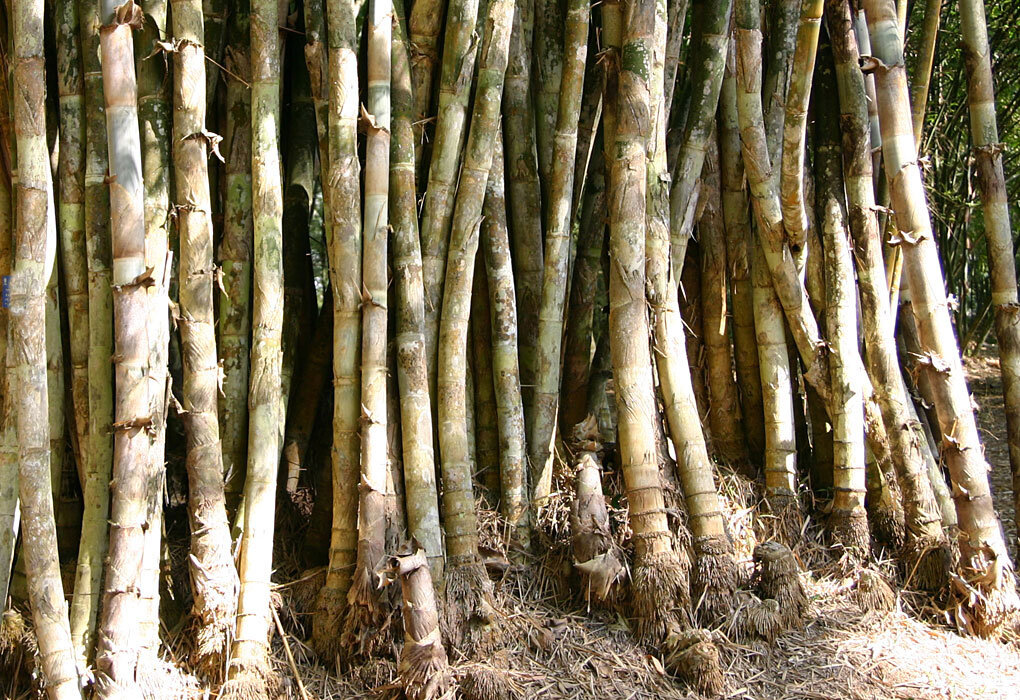Bambusa polymorpha
Bambusa polymorpha, commonly known as Burmese Bamboo, is a large dense clumping tropical bamboo native to Bangladesh, China, Laos, Myanmar, Thailand. It is a bamboo of many uses with sweet tasting edible shoots.
| Plant Info | |
|---|---|
| Scientific Name | Bambusa polymorpha |
| Synonyms | Arundarbor polymorpha, Bambusa cyanostachya |
| Common Names | Burmese Bamboo |
| Family | Poaceae |
| Tribe | Bambuseae |
| Genus | Bambusa |
| Height | 15 - 25 m |
| Diameter | 7 - 15 cm |
| Growth Habit | Dense Clumping |
| Color | Light green or grayish white when young. |
| Internodes | 40 - 60 cm |
| Wall thickness | 10-20 mm (occasionally solid near the base). |
| Branches | Several or many clustered branches with 1-3 larger branches. |
| Leaves | 7-17 cm long, 7-12 mm wide. |
| Climate | Tropical - Subtropical |
| Exposure | Full Sun - Partial Sun |
| Hardiness | 0°C |
| Soil | Loamy and alluvial soils, fertile and well drained. |
| Water Needs | Average. |
| Planting Distance | • Every 3 m for screening. • 7 x 7 m for culm production. |
| Edibility | (4 of 5) |
| Flowering Cycle | 35-80 years |
| Origin | Bangladesh, China, Laos, Myanmar, Thailand. |
| Uses | Construction, furniture, basketry, weaving, handicrafts, paper pulp, food, laminated boards, landscaping. |
Rhizomes
Bambusa polymorpha has short pachymorph rhizomes which means that it grows in densely tufted clumps.
Culms
This is a medium to large size densely tufted bamboo with culms between 15-25 m tall. Culm internodes are on average 40-60 cm long with 7-15 cm in diameter. The color of the culms is light green or white grey when young to greyish-green and have relatively thick walls of 1-2 cm (occasionally solid near the base). The thick lower nodes are rooted.
Shoots
Young shoots have a brownish-green color, and are covered with dark brown hairs.
Branches
Bambusa polymorpha has several to many clustered branches with 1-3 larger dominant branches. Branches usually occur from middle of the culm to the top.
Leaves
Leaves are lance-shaped and 7-17 cm long and 7-12 mm wide.
Seeds
Both gregarious and sporadic flowering occurs every 35-80 years.
Habitat
Bambusa polymorpha grows naturally in semi-humid areas on deep, fertile, well-drained alluvial and loamy soil. It usually occurs on low hill slopes along valleys, mixed with deciduous forests and among teak (Tectona grandis).
Mechanical Properties
Fiber stress at elastic limit is 13.6 and 16.1 N/mm2, modulus of rupture 28.3 and 35.5 N/mm2, modulus of elasticity 3.1 and 4.1 kN/mm2 in green and air-dry conditions respectively.
Plant Spacing
Living fence: Every 3 m
Erosion control: 3 x 3 m (1111 plants/ha)
Medium sized culm production: 5 x 5 m (400 plants/ha)
Large sized culm production: 7 x 7 m (204 plants/ha)
Uses
Bambusa polymorpha is a bamboo with many uses. Culms are used for house construction, woven matting, baskets, furniture, handicrafts, and as a raw material for paper pulp and board making. This bamboo produces edible shoots with a distinctly sweet taste. It is also a graceful species suitable for landscaping.
Origin
Native to:
Bangladesh, China, Laos, Myanmar, Thailand
Introduced into:
Assam, Cuba, East Himalaya, Ecuador, Java, Puerto Rico, Sri Lanka, Trinidad-Tobago










Date planted: 22 June 2021
Growth update: 19 March 2022
Adopted by: